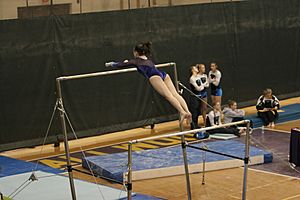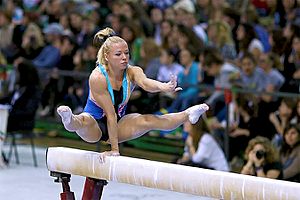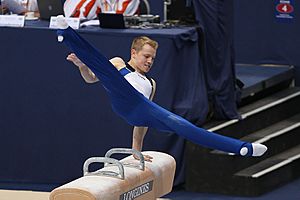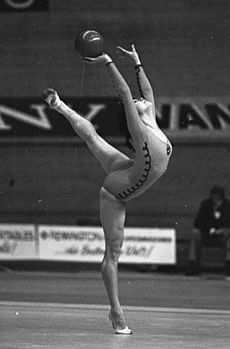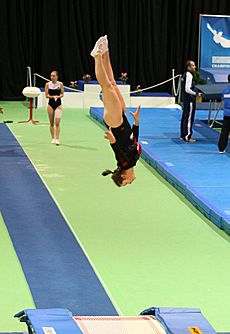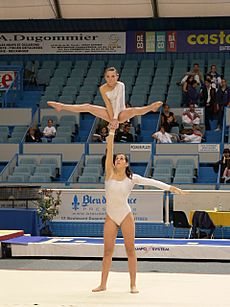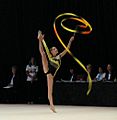Gymnastics facts for kids
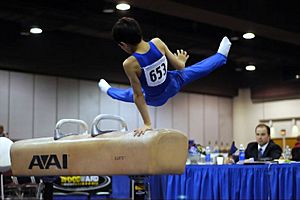
Gymnastics is a fun and challenging sport. It involves exercises that need strength, flexibility, balance, and control. This can include running, jumping, tumbling, somersaulting, flipping, and balancing.
In women's gymnastics, there are four main events: floor, uneven bars, balance beam, and vault. For men's gymnastics, there are six events: floor exercise, parallel bars, high bar, pommel horse, vault, and rings.
Gymnastics is also an Olympic sport, meaning you can see it at the Olympic Games!
Contents
History of Gymnastics
Gymnastics started as a way to exercise in ancient Greece. It was one of the first sports ever in the Olympics. Back then, only men could compete in the Olympic Games. However, there was another festival called the Herean Games where women could compete.
Types of Gymnastics
Artistic Gymnastics
Artistic Gymnastics is usually split into Men's and Women's Gymnastics. Men compete on six different pieces of equipment: Floor Exercise, Pommel Horse, Still Rings, Vault, Parallel Bars, and Horizontal Bar. Women compete on four: Vault, Uneven Bars, Balance Beam, and Floor Exercise.
Since 2006, artistic gymnastics uses a new scoring system. Scores are no longer limited to 10 points. Now, there are two separate scores: a difficulty score and an execution score. The execution score is still out of 10.00 points. Judges take points off for mistakes, like falling. A fall usually means a 1.00 point deduction.
The difficulty score is new. It depends on how hard the skills a gymnast performs are. The harder the skills, the higher the difficulty score can be. There is no maximum score for difficulty. This new system lets gymnasts get higher scores for doing very difficult moves.
Artistic Events for Women
Vault
In vaulting, gymnasts run down a 25 metres (82 ft) runway. They jump onto a springboard. Then they briefly place their hands on the vaulting table. From there, they push off and do flips or twists before landing on two feet. Each gymnast starts at a different spot on the runway.
A common vault in higher levels is called a Yurchenko. For this vault, gymnasts do a "round off" onto the springboard. Then they do a back handspring onto the vaulting table. After pushing off the table, they perform twists or somersaults before landing.
In 2001, the old vaulting horse was replaced with a new, wider, and more stable vaulting table. This new table is about 1 meter long and 1 meter wide. It gives gymnasts a bigger surface to push off from. This makes the vault safer and allows gymnasts to try more difficult moves.
Uneven Bars
On the uneven bars, gymnasts perform a routine on two horizontal bars at different heights. These bars are made of fiberglass covered in wood. This makes them strong and prevents them from breaking. The bars can be adjusted for each gymnast.
In the past, the bars were closer together. Now, they are further apart. This allows gymnasts to do big swings, circles, and release moves. They can pass over, under, and between the two bars. Gymnasts often use a springboard to get onto the bars. They also use chalk and special grips. Chalk helps keep hands dry, and grips protect hands and help with holding the bar.
Balance Beam
Gymnasts perform a routine up to 90 seconds long on a padded beam. The beam is 125 centimetres (4 ft 1 in) off the ground, 500 centimetres (16 ft 5 in) long, and only 10 centimetres (3.9 in) wide. The routine includes leaps, acrobatic skills, somersaults, turns, and dance moves. This event needs great balance, flexibility, grace, and strength.
Floor
The floor exercise is performed on a special carpeted square that is 12m × 12m. It usually has hard foam over plywood supported by springs. This "spring" floor gives gymnasts extra bounce. It helps them get higher for their skills and land softer.
Gymnasts perform a choreographed routine up to 90 seconds long. For higher levels (levels six to ten), gymnasts can choose their own music without words. The routine must include tumbling passes, jumps, leaps, dance moves, and turns. Gymnasts can do up to four tumbling passes. Each pass usually has at least one skill where they are in the air without hand support.
Artistic Events for Men
Floor
Male gymnasts also perform on a 12m x 12m spring floor. They do a series of tumbling passes to show their flexibility, strength, and balance. Their routines usually last between 60–70 seconds. Unlike women's routines, men's floor routines are performed without music. Rules say male gymnasts must touch each corner of the floor at least once.
Pommel Horse
A pommel horse routine involves both single-leg and double-leg moves. Single-leg skills often look like scissors. Double-leg work is the main part of this event. The gymnast swings both legs in a circular motion. They perform skills on all parts of the equipment. To make it harder, gymnasts might turn or spread their legs wide. Routines end with a dismount, where the gymnast swings off or lands after a handstand.
Still Rings
The rings hang from cables 5.75 meters above the floor. Gymnasts must perform a routine showing balance, strength, power, and movement. They must also try to keep the rings from swinging. At least one static strength move is required. The routine finishes with a dismount.
Vault
Male gymnasts sprint down a runway, up to 25 meters long. They jump onto a springboard. They keep their body position while pushing off the vaulting platform. Then they rotate to a standing position. In advanced gymnastics, they might add twists and somersaults before landing. Good vaults depend on speed, power, and how well they land.
Parallel Bars
Men perform on two parallel bars. They do a series of swings, balances, and release moves. These require great strength and coordination. The bars are usually 2 meters high. The width between them can be adjusted for each gymnast.
Horizontal Bar
This event uses a 2.8 cm thick steel or fiberglass bar. It is raised 2.5 meters above the landing area. The gymnast holds onto the bar and performs giant swings (revolutions around the bar in a handstand). They also do release skills, twists, and changes of direction. Using the momentum from giant swings, gymnasts can get enough height for amazing dismounts, like a triple-back salto. Leather grips are often used to help hold onto the bar.
Just like women, male gymnasts are judged on their execution, degree of difficulty, and overall presentation.
How Gymnastics is Scored
A gymnast's score comes from two main parts: the D score and the E score.
- The D score (Difficulty score) is based on how hard the elements the gymnast tries are. It also checks if they meet certain requirements for the routine.
- The E score (Execution score) starts at a maximum of 10.0 points. Judges take points off for mistakes in how the skills are performed and for artistry.
The final score is found by taking deductions from the E score and adding that result to the D score. Since 2007, the scoring system has changed a bit. Now, bonus points are added to the execution score, and then those are added to the difficulty score to get the final score.
Landing Safely
Landing is the last part of a tumbling pass, dismount, or vault. It's very important for good scores and to avoid injuries. If gymnasts don't absorb enough energy when they land, they can get hurt. Injuries often happen in the legs, like to cartilage, ligaments, or bones.
To avoid injuries and get a high score, gymnasts must use proper technique. A good landing means landing softly on both feet. Their knees and hips should be bent more than 63 degrees. Landing higher means more force on the ground. Gymnasts can reduce this force by taking more time to land. They do this by bending their hips, knees, and ankles more.
Rhythmic Gymnastics
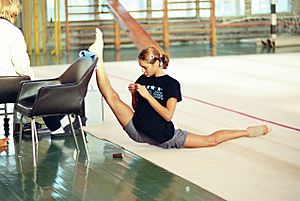
According to rules, only women compete in rhythmic gymnastics. This sport combines parts of ballet, gymnastics, dance, and using special equipment. Gymnasts perform five different routines using a ball, ribbon, hoop, clubs, or rope. The focus is more on beauty and grace than on acrobatic moves. There are also group routines with 5 gymnasts and 5 pieces of equipment.
Rhythmic routines are scored out of 30 points. The score for artistry (how well the routine is choreographed and uses music) is averaged with the score for difficulty. Then, the score for execution (how well the moves are performed) is added.
International competitions are for Juniors (under 16) and Seniors (16 and over). Gymnasts often start training very young. The biggest events are the Olympic Games and World Championships. Rhythmic gymnastics first appeared at the Olympics in 1984.
Rhythmic Gymnastics Equipment

Trampolining and Tumbling
Trampolining and tumbling has four events: individual trampoline, synchronized trampoline, double mini trampoline, and tumbling. Individual trampoline has been part of the Olympic Games since 2000. The first World Championships for these events were held in 1964.
Trampolining
Individual Trampoline
In individual trampoline, gymnasts first jump repeatedly to gain height. Then, they perform a sequence of ten bounces without stopping. During these bounces, they do aerial skills. Routines are scored out of 10 points. Extra points can be earned for how difficult the moves are and how long it takes to do the ten skills. This shows how high the jumps are.
Synchronized Trampoline
Synchronized trampoline is similar, but two gymnasts perform the routine together. Points are given for how well they stay in sync, as well as for their form and difficulty.
Double-Mini Trampoline
Double mini trampoline uses a smaller trampoline with a run-up. Gymnasts perform two scoring moves per routine. They cannot repeat the same moves in the same order during a competition. Scoring is similar to individual trampoline.
Tumbling
In tumbling, athletes perform a fast series of flips and twists down a sprung tumbling track. Scoring is similar to trampolining. Tumbling was once an Olympic event for men in 1932. It has been part of the Trampoline World Championships since 1976.
Acrobatic Gymnastics
Acrobatic gymnastics is a group sport for both men and women. Acrobats work in groups of two, three, or four. They perform routines using their partners' heads, hands, and feet. They can choose their own music, as long as it doesn't have lyrics.
Most competitions require both a balance routine and a dynamic routine. Some might have a single mixed routine.
Aerobic Gymnastics
Aerobic gymnastics involves routines performed by individuals, pairs, trios, or groups of up to six people. It focuses on strength, flexibility, and aerobic fitness. It's less about acrobatic or balance skills. Routines are performed on a 7x7 meter floor for individuals, and for younger trios and mixed pairs. Older groups and pairs use a larger 10x10 meter floor. Routines usually last 60–90 seconds. The World Championships have been held since 1995.
The events include:
- Individual Women
- Individual Men
- Mixed Pairs
- Trios
- Groups
- Dance
- Step
Parkour
On January 28, 2018, Parkour was approved to become a sport under the International Gymnastics Federation (FIG). The FIG plans to hold World Cup competitions for Parkour and will have the first Parkour World Championships in 2020.
The events include:
- Speedrun
- Freestyle
In rhythmic gymnastics, gymnasts perform with ribbons, rope, ball, hoop, and clubs. Usually, only women do rhythmic gymnastics because they are often more flexible than boys.
Images for kids
-
Daniele Hypólito performing on the balance beam.
See also
 In Spanish: Gimnasia para niños
In Spanish: Gimnasia para niños




